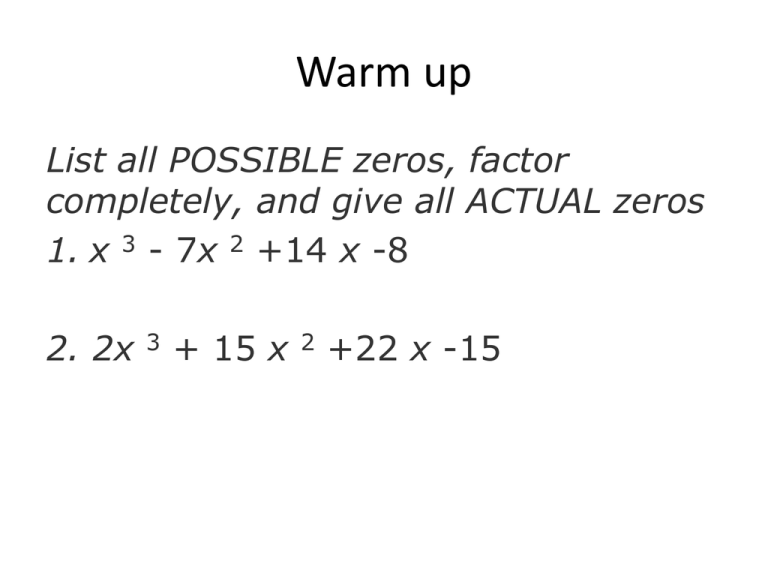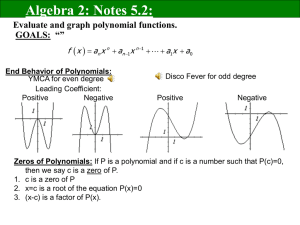Polynomial PPT
advertisement

Warm up List all POSSIBLE zeros, factor completely, and give all ACTUAL zeros 1. x 3 - 7x 2 +14 x -8 2. 2x 3 + 15 x 2 +22 x -15 Warm up 1. List all POSSIBLE zeros, factor completely, and give all ACTUAL zeros x3 + x2 - 10x + 8 2. Write a polynomial in standard form with the given zeros. 0, -1, 2 3. Divide the following using SYNTHETIC DIVISION Warm up 1. Check if x + 3 is a factor of f(x) = 2x 3 + 15 x 2 +22 x -15 2. Check if x - 2 is a factor of f(x) = x 3 - 7x 2 +14 x -8 3. Check if x - 3 is a factor of f(x) = 2x 3 + 15 x 2 +22 x -15 Warm up 1. Write a polynomial in standard form with the given zeros. a. 5/3, 1 , -1 b. 5, -1, 0 Divide the following using SYNTHETIC DIVISION. Show all work. Warm up 1. Write the polynomial in standard form and give the degree. 2. Divide the following using LONG DIVISION. Show all work. 3. Divide the following using SYNTHETIC DIVISION. Divide 2x3 + 11x2 - 2x – 25 by 2x + 3 Divide 3x3 – 5x2 + 10x – 3 by 3x + 1 Writing a polynomial function from zeros Steps • Convert the zeros to factors. • Multiply the factors. • Combine like terms and write with powers of x in descending order, which is the standard form of a polynomial function. Writing Polynomial Function from its Zeros Zeros means the value of x at which the value of y is zero. Write a polynomial function from its zeros Suppose the zeros of a polynomial are -4, 1, and 2 Y=? Y =(x+ 4) (x- 1) (x – 2) Y = x3 + x2 - 10x + 8 Check: These values of x cause this polynomial equal to zero. Write a polynomial in standard form with the given zeros. 1. 0, -3 2. 5, -1, 0 3. 2, 3, 3 5. 5/3, 1 , -1 6. -1, 3/2 Questions What are the zeros of the polynomial function y = (x 3) (2x – 5) (x – 6) Which polynomial function has zeros at -4, 3, and 5? a. f(x) = (x + 4)(x + 3)(x + 5) b. g(x) = (x + 4)(x - 3)(x - 5) c. h(x) = (x - 4)(x - 3)(x - 5) d. k(x) = (x - 4)(x + 3)(x + 5) Write a polynomial function of least degree with integral coefficients that has the given zeros? 1.) 3, 2, -2 2.) 3, 1, -2 3.) 5, -1, 0 4.) -3, -1/3, 5 5.) 5/3, 1, -1 6.) 2, 5/3, -5 If the given number x = a is a zero of the polynomial function f(x), then f(a) = 0. Example: Verify if the given number is a zero of the function. Verify if the given number is a zero of the function m 14m 42m 29, x 9 3 2 Rational Zero Theorem If a polynomial function, written in descending order of the exponents, has integer coefficients, then any rational zero must be of the form ± p/ q, where p is a factor of the constant term and q is a factor of the leading coefficient. Rational Zeros Steps to finding all rational zeros: 1) List the possible rational zeros by calculating p/q. 2) Use synthetic division to test the polynomial at each of the possible rational zeros that you found in step 1. OR Graph the function using your calculator to find a starting point by identifying just one rational zero. (If there are no rational zeros, you are done.) 3) Perform synthetic division on your polynomial using the rational zero from step 2. 4) Repeat step 2 until you reach a quotient that is a quadratic or factors easily. Use the quadratic formula or factoring to find the remaining zeros. Find all the rational zeros of f ( x) = 2 x 3 + 3 x 2 – 8 x + 3 P: Factors of 3 = ± 1, ± 3 q: Factors of 2 = ± 1, ± 2 The possibilities of p/q are ± 1, 1 ± 2 ,± 3,± 3 2 How do you find all the rational zeros of a polynomial function? 1. x 3 - 7x 2 +14 x -8 (1, 2, 4) 2. 2x 3 + 15 x 2 +22 x -15 (-3, -5, ½) The Factor Theorem If the function f(x) = 0 at x = a, then (x – a) must be a factor of the polynomial. Example: x2-3x-4 f(4) = (4)2-3(4)-4 = 16-12-4 = 0 So (x – 4) must be a factor of x2-3x-4 1. Check if x - 2 is a factor of x 3 7x 2 +14 x -8 2. Check if x +5 is a factor of F(x) = 2x 3 + 15 x 2 +22 x -15 The Remainder Theorem: When we divide a polynomial f(x) by x- a the remainder equals f(a) Find the remainder when 2x2-5x-1 divided by x-3 Calculate f(3) to find the remainder. F(3) = 2(3)2-5(3)-1 = 2x9-5x3-1 = 18-15-1 = 2 Remainder is 2. Find the remainder when x3 + x2 - 10x + 8 is divided by (x + 2). End Behavior of the Polynomial Function The end behavior of a polynomial function is the behavior of the graph of f(x) as x approaches positive infinity or negative infinity. The degree and the leading coefficient of a polynomial function determine the end behavior of the graph of polynomial. End Behavior 1. If the degree n of a polynomial is even, then the arms of the graph are either both up or both down. 2. If the degree n is odd, then one arm of the graph is up and one is down. 3. If the leading coefficient is positive, the right arm of the graph is up. 4. If the leading coefficient an is negative, the right arm of the graph is down. Moe Specific Feasible Cases of End Behavior Feasible Cases: Case 1: If Leading coefficient(an) is positive and the power(n) is even, both ends of the graph go up. Case 2: If Leading coefficient(an) is negative and the power(n) is even, both ends of the graph go down. Case 3: If Leading coefficient(an) is positive and the power(n) is odd, the right hand of the graph goes up and the left hand goes down. Case 4: If Leading coefficient(an) is negative and the power(n) is odd, the right hand of the graph goes down and the left hand goes up. End Behavior A polynomial function is a function of the form where each of the coefficients (the a’s) is a real number and all exponents are positive. The domain is all real numbers. The graph is continuous and created with smooth curves. Polynomial function of odd degree, positive leading coefficient. Polynomial function of odd degree, negative leading coefficient Polynomial function of even degree, positive leading coefficient. Polynomial function of even degree, negative leading coefficient • • • • Algebra II Name: _________________________ Symmetry & End Behavior Date: __________ ______ Circle whether the function is even, odd or neither. Then describe end behavior of the graph of the polynomial function by filling in the blanks with . 1. f(x) = -6x3 + 8x • • End Behavior: the left side goes __________ • • the right side goes _________ 2. • • End Behavior: the left side goes __________ • the right side goes _________ • 3. • • End Behavior: the left side goes __________ • the right side goes _________ • 4. • • End Behavior: the left side goes __________ • the right side goes _________ • 5. • End Behavior: f(x) = 7x4 - x3 + 7x + 1 f(x) = 5x3 - 5x2 - 7x – 3 f(x) = 2x2 – 1 f(x) = x5 - 6x7 - 4x Use what you know about end behavior to match the polynomial function with its graph. 9. f ( x) 4 x 6 3x 2 5 x 2 10. f ( x) 2 x3 5x 2 11. f ( x) x 4 1 12.f ( x) 6 x3 1 y y A. B. x C. x D. y x y x List all POSSIBLE zeros, factor completely, and give all ACTUAL zeros. • What is the equation for the cubic model? • Can you predict the value of y for x = 17? • Steps to Finding a Cubic Regression using a graphing calculator: • 1) Go to Stat 1:Edit and enter the data into L1 and L2 • 2) Go to 2nd Y= and turn Plot1 On. • 3) Go to Stat, Calc, 6:CubicReg, VARS, Y-VARS, Enter, Enter, Enter. • 4) Look at your graph by using Zoom 9:ZoomStat • 5) Look at your equation by going to Y=. • 6) Calculate a value by using 2nd Trace, 1:Value, X=. Comparing Model • Below is 3 scatterplots for the given data. Each scatterplot is fitted with a different model. Which model is the best fit?









